

Although Epic Two proved to be an enormously entertaining game to play, one of the problems with the scoring (as we found out once the reports came out) was that the points were highly geared towards endgame sandbagging. I felt like I had gone too far in this direction, but I was in fact outdone by several of our players who went even FURTHER down the path of milking points at the end of the game for score. The lesson I learned is that if you're going to go down that path, you might as well go whole-hog or avoid it altogether. In the event that we should get another game with that type of scoring, I plan to just win the darn thing and not hang around for more points.
I mention that here because "just win the darn thing" was the overriding goal for my game here in Epic Three.  As far as this game goes, we won't have any clue how the scoring went until after all the reports are posted when the game concludes. In short, points are scored for the players who have the highest populations at two benchmark dates (1AD and 1500AD), the players who reach the Modern Age the fastest, the players who have the largest city at the end of the game, and the players who have the fastest Conquest/Cultural/Diplomatic victories. (For the full details, see this page.) Of course, the beauty of this scoring system is that most of the scoring goals are contradictory to one another, and not in the phony way that the Epic Two scoring goals were (in which certain paths would clearly score enormously more points than others). An early Conquest victory is not going to score well in the Large City category, while a Cultural Victory focusing on wonder-building probably won't have as much population. This game really is wide open, more so than any event since Epic One, and I'll be quite interested to see what different paths each person chose to go down.
As far as this game goes, we won't have any clue how the scoring went until after all the reports are posted when the game concludes. In short, points are scored for the players who have the highest populations at two benchmark dates (1AD and 1500AD), the players who reach the Modern Age the fastest, the players who have the largest city at the end of the game, and the players who have the fastest Conquest/Cultural/Diplomatic victories. (For the full details, see this page.) Of course, the beauty of this scoring system is that most of the scoring goals are contradictory to one another, and not in the phony way that the Epic Two scoring goals were (in which certain paths would clearly score enormously more points than others). An early Conquest victory is not going to score well in the Large City category, while a Cultural Victory focusing on wonder-building probably won't have as much population. This game really is wide open, more so than any event since Epic One, and I'll be quite interested to see what different paths each person chose to go down.
Here was my thinking for the game. A True Diplomatic victory with less than 40% of the overall population is going to be tough to do; in all likelihood, you're going to need to get 2 of the other 3 leaders to vote for you. That is, everyone except your opponent is going to have to vote for you, and we all know how tough that is to pull off in Civ4. Furthermore, I think there's a good chance that most players will out-grow the AI (even accidentally!) and end up in the lower-scoring "Backdoor Domination" category without even meaning to do so. I don't really feel like jumping through hoops to avoid reaching a large population, so that's out for me. As far as Cultural victory goes... I've never gotten one of those, so I'm sure that many people can do that a lot faster than I can. (I think I need to run a Succession Game soon just to get a Cultural victory - especially with some kind of variant twist!  ) Furthermore, Cultural victory is always the wildcard victory; maybe no one will chase after it and it will be easy to score points, OR maybe a lot of people will go after it, thinking "no one is going to take this one!" and outthink themselves. You never know. I'm just going to stay away from this area entirely.
) Furthermore, Cultural victory is always the wildcard victory; maybe no one will chase after it and it will be easy to score points, OR maybe a lot of people will go after it, thinking "no one is going to take this one!" and outthink themselves. You never know. I'm just going to stay away from this area entirely.
Well that leaves Conquest Victory. You know what, I haven't gotten a Conquest victory since RB1 and I'm feeling the need to do some warring. All game planning aside, I also thought this would be the most fun to play. My poorly-planned One City Challenge didn't go so well in the original (Civ3) Epic Three, so now I will return and inflict some vengeance on these AI clowns!  As far as the other scoring goals... Conquest will fit well with the population milestones, so I planned to focus heavily on them. I thought quite a lot about how to get a very Large City, so we'll see how that goes; of course, if I won TOO fast, I wouldn't have enough time to grow the city that big. Par for the course, naturally. Fastest Modern Age is going to be very tough to score in, so I'll just do the best I can there. Let's get this started!
As far as the other scoring goals... Conquest will fit well with the population milestones, so I planned to focus heavily on them. I thought quite a lot about how to get a very Large City, so we'll see how that goes; of course, if I won TOO fast, I wouldn't have enough time to grow the city that big. Par for the course, naturally. Fastest Modern Age is going to be very tough to score in, so I'll just do the best I can there. Let's get this started!
I had three major goals for the game that I wrote down before even starting:
1) Expand, expand, expand!
2)Cottage spam for economy
3)Draft and conquer post-1500AD
We'll get to the last one a bit later on, but for now I thought the best plan was to expand as fast as I possibly could prior to the 1AD population benchmark. Fortunately, as a Financial civ, Huayna Capac is well suited to the kind of cottage-spamming it takes to sustain the economy of a bloated empire.
I moved one space northeast on the first turn to get the cows in range of the capital, founding in 3970. That also put me on the coast with two freshwater lakes in range, which would be 3 food/3 commerce with a lighthouse. Excellent! I began with a worker, as I usually do. Now, lest you think that I ALWAYS start with a worker to begin, I must say that I was operating under the assumption that my civ was isolated here on its own island. I rolled a half-dozen maps with the game settings Sirian had given us, and only once did I see two civs starting on the same island. It seemed logical therefore to assume that we would be on our own island, and so there was no particular rush to get out there exploring, even on a Large map. What's the hurry? Those huts will still be there later, and there's even no barbs for this game. I would focus instead on growth and pop out the worker ASAP. Research was into Meditation for Buddhism; with no other civs starting with Mysticism, we had a 100% guaranteed religion to start the game, and I would have been a fool to pass that up for such an easy initial investment of a dozen or so turns. In fact, it would have been very easy to pull off a "hydra" strategy here, and that may well be a huge factor in a Diplomatic or Cultural path. I'll be interested to see what others did here as far as the religions. LOTS of potential routes that could all be viable.
Cuzco founds Buddhism in 3490BC:
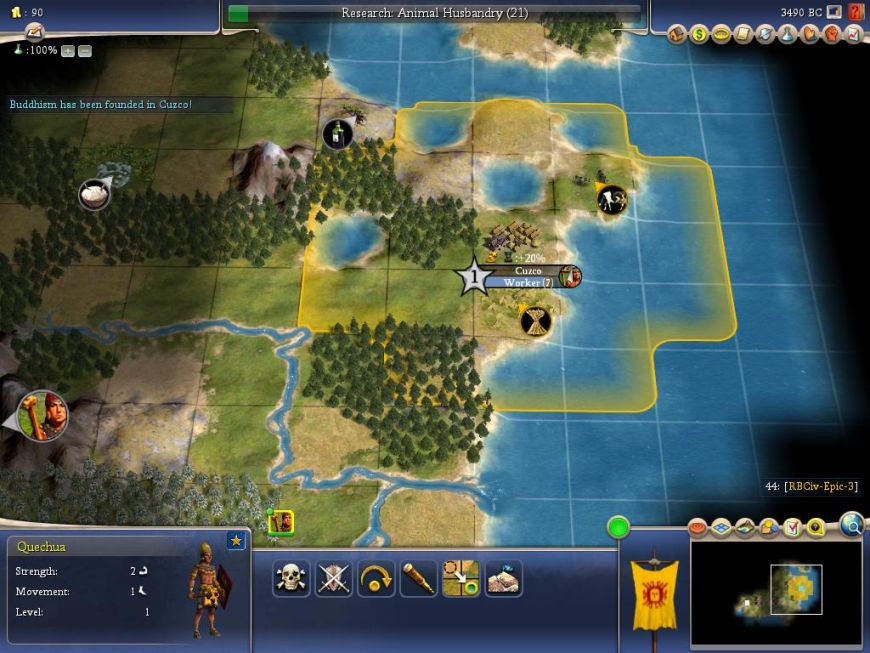
Naturally the next research is into Animal Husbandry to hook up the cows (I already had Agricultural for the wheat). My quechua had already found two huts and popped gold from each; that was nice, but either Mining or Wheel tech would have been a much better boost. Oh well. I expect other players to get more out of the many huts on this large map than I did. After finishing the worker, I started a second quechua. What's the point of building a barracks? And I'm NOT going for Stonehenge in this game, so no need to put shields into that. A wonder like Stonehenge will only slow me down in my expansion. I do expect a lot of other players to go after it though, it's a natural thing to build with so much land to expand into.
Then in 3100BC, disaster strikes - I'm on a continent with Louis! 
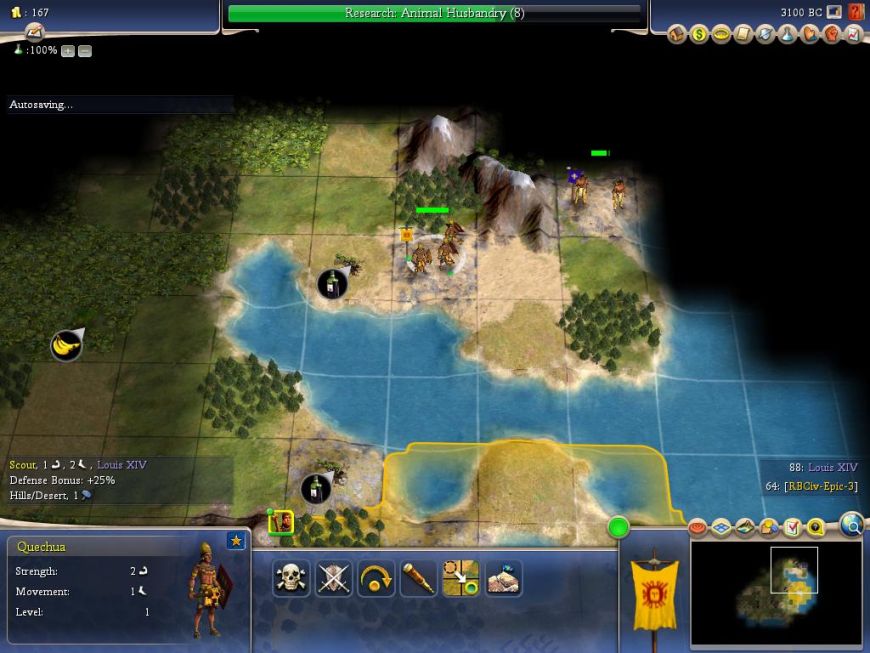
Argh, my plans for a glorious builder's paradise have gone down the tubes. Now I will actually have to guard my cities and put up a credible defense. Seriously, what were the odds that we would start on a continent with one of the 3 AI civs? It can't have been much higher than 20%. Much of my pre-game planning is now out of the window, but of course I will just have to adapt and adjust.
The one bad consequence of going for Buddhism was that after my worker finished building a farm on the wheat tile, he had nothing to do for a couple turns until Animal Husbandry came in. Since this was a no barbs game (which is a world all unto itself), I actually sent the worker out scouting for a few turns until the tech came in. Heh. You certainly won't do that normally! When I did finish Animal Husbandry in 2860, I started research on Wheel -> Pottery. That may have been a mistake, as I perhaps should have gotten Mining in here and mined that plains hill at Cuzco, but I did need to get the cottages up and running ASAP. Hopefully it didn't make a huge difference. The capital produced a second quechua in 2860BC, and he went out exploring as well. I had been running max food the whole time, and when Cuzco hit size 3 in 2740BC, I started on a settler (19 turns).
After that, not much happened for a dozen or so turns. My quechuas explored while my worker built roads, then cottages, while the capital built that settler. Louis was off to a very rapid start, getting out to three cities at the same time that I was at two. Quite impressive; I was shadowing one of his settler/archer pairs with a quechua and watching his growth take off. In fact, I realized, given the Incan extremely early unique unit's special abilities, I decided that I may as well put that to good use by slowing down Louis early on. Therefore, I took a huge gamble in 2260BC:
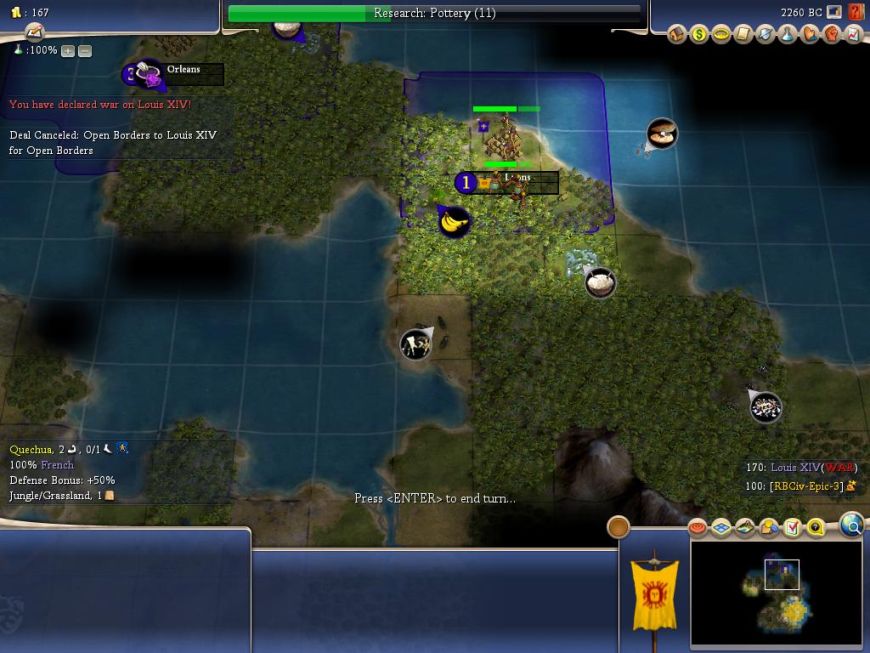
WAR! I planned to raze Lyons, just to slow Louis down a bit. It was one quechua vs. one archer, and I had about 2/3 odds to win... but the dice were unkind and I lost. Nuts.  Certainly well within the odds of losing there, but that would have been a big boost. I grabbed the other quechua I had out exploring, as well as the second quechua I produced in Cuzco after finishing my settler, and sent them up north towards Louis, hoping for another target of opportunity to emerge.
Certainly well within the odds of losing there, but that would have been a big boost. I grabbed the other quechua I had out exploring, as well as the second quechua I produced in Cuzco after finishing my settler, and sent them up north towards Louis, hoping for another target of opportunity to emerge.
By the way, I'm at war with an undefended capital at the moment. I think playing these games has finally made me crazy. 
I founded Tiwanaku, my second city, on the river to the west in 2230BC. It had the potential to be a cottage paradise, but I chose not to go that route and instead would irrigate the grasslands and mine its hill tiles. I needed my second city to focus on production, since the capital would be tied up on worker/settler builds for the immediate future. I would have the city build a barracks and quite a few quechuas for my other new cities, just to be safe. I also had plans for that city to build my "ace in the hole" for the 1AD population scoring... the Hanging Gardens! If there's one thing that I learned from reading some of the high-scoring games at CivFanatics, it's that the Hanging Gardens is the best way to increase your population in a hurry. I planned to bend my civ towards that goal and time the Gardens to complete on the exact turn of the population scoring, providing a huge bump upwards as every city increased by a population point. Of course getting it by 5AD could be tricky (remember, you need to build an acqueduct first!) but I think I'm a pretty resourceful fellow, so I should be able to manage something.
So with Tiwanaku focusing on shields (and some light military), Cuzco remained locked on building settlers and workers, running max food during the brief periods it worked on something else to increase population. With the focus on growth across my civ, this was truly the Age of the Plow. Meanwhile, as I added a third city in 1390BC to the south of Tiwanaku, I had a pair of quechuas working their way through Louis' core pillaging everything in sight:
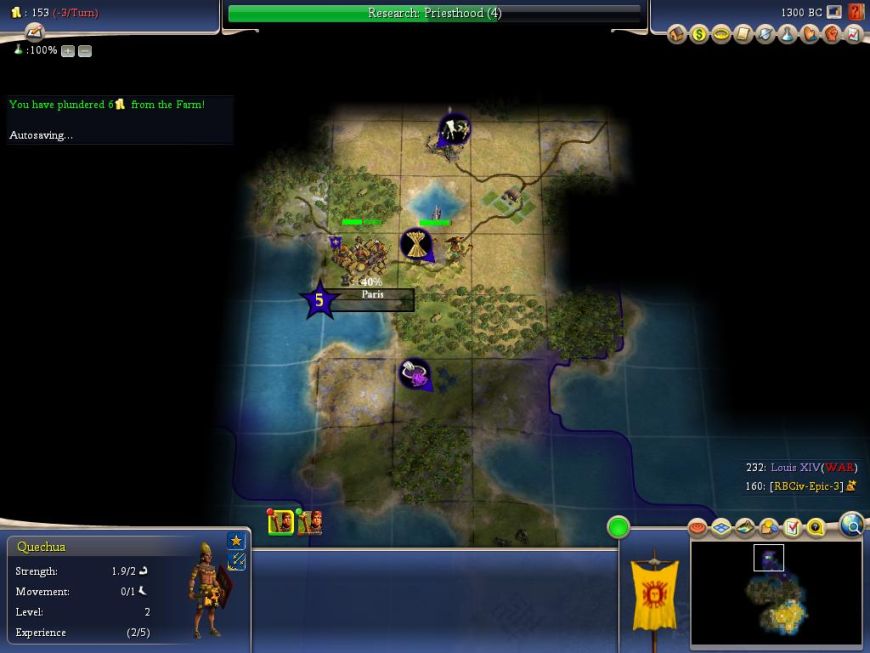
It was one of the strangest wars I can ever recall fighting. While my cities in the south were either running max growth or building workers/settlers, this little pair of quechuas was quietly pillaging Louis back to the stone age. Our vets will remember what happened to the Civ3 AIs in Epic Fourteen, and I was doing my conscious best to repeat it here. See, one of the great things about the quechua is that even if you don't have enough force to actually take AI cities outright (and I didn't, thanks to Louis' free cultural border defenses) you can move around at will pillaging to your heart's content. All of the French cities were stacked to the gills with archers, so I didn't dare attack them, but Louis was powerless to prevent my pillaging. This little pair of two guys stripped his whole lands bare. I survived quite a few attacks from French archers too, thanks to staying on defensive terrain wherever possible. For the cost of two warriors, I hamstrung an entire Monarch AI. Amazing stuff. The window of opportunity for the quechua is very narrow, so you'd best make good use of it!
You can see I was researching Priesthood above... I realized when I was done researching it that that was a mistake, because I wouldn't have time to build both the Oracle and Hanging Gardens before 1AD. It was one or the other, and I was determined to get the Gardens. The Civil Service slingshot was certainly there for the taking, and there's a good chance that players who go that route (coupled with early Academy in the capital) will do very well indeed. I'll be interested to compare with those who went down that path on report day; in all likelihood, they'll have a good chance of outscoring me in this game.
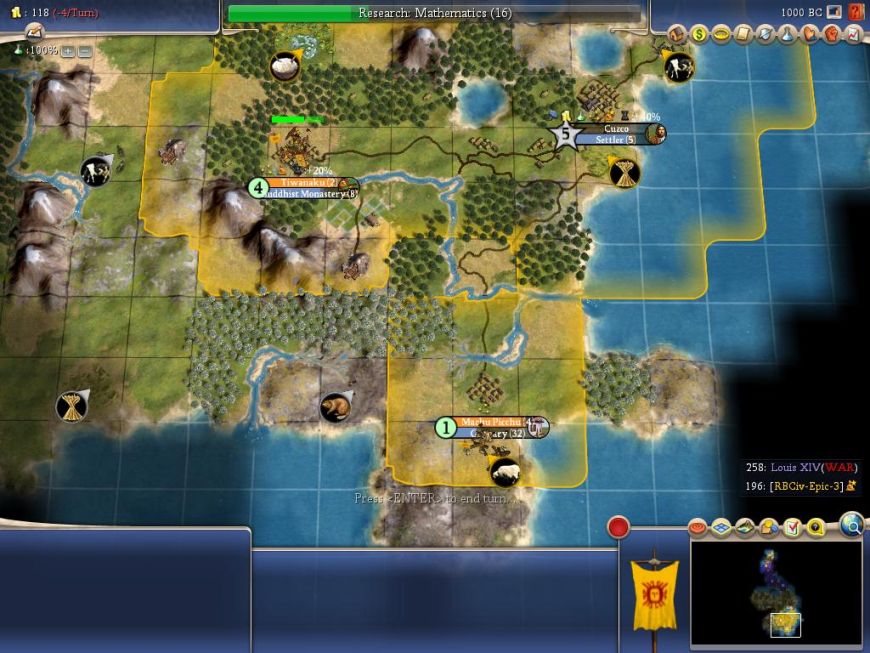
Here we are in 1000BC. I only have three cities, but there is another one in production right now. One bad mistake on my part has been not mining that plains hill at Cuzco yet; what was I thinking! I was losing a shield every single turn I was building a worker or settler, which was almost every turn. Argh. Machu Picchu is a city in cottage heaven; it will grab the sheep tile and then cottage basically everything else. A great spot for the third city. Researching Math at full speed (I still don't have Bronze Working or Fishing yet!) in order to get the Gardens in play by the deadline.
Up in France, Louis founded the city of Tours and had two archers in it. When I moved up next to the city, Louis attacked out of it with one of the two archers, killing my wounded quechua, BUT that allowed my other quechua to attack the city at 75% odds, winning and auto-razing the new settlement!
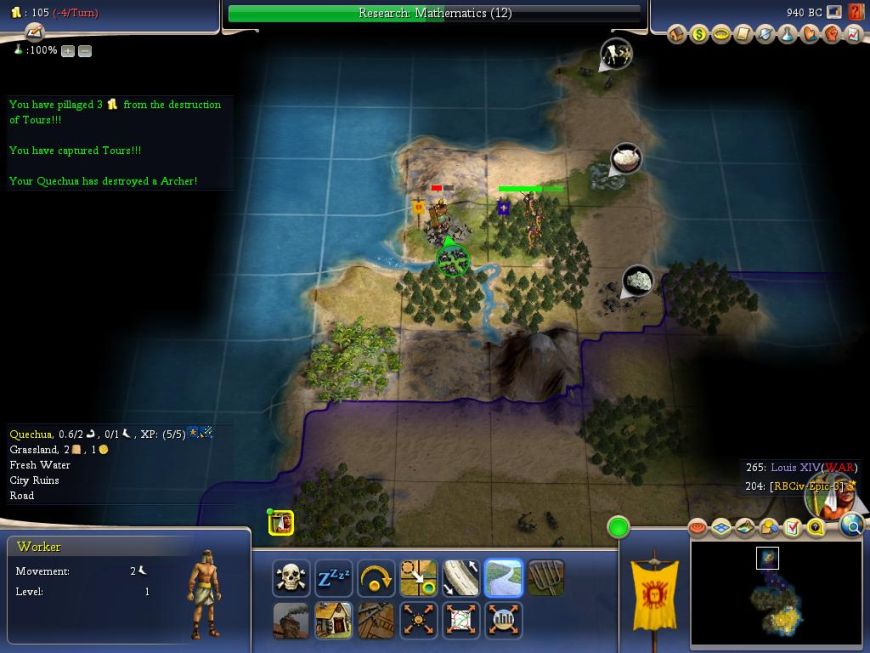
Whoops, I think you may have made a tactical error there Louis.  And although the archer clearly could have killed my remaining quechua, for whatever reason he headed off to the east without attacking. I happily promoted my remaining guy and healed up, then went back to pillaging some more.
And although the archer clearly could have killed my remaining quechua, for whatever reason he headed off to the east without attacking. I happily promoted my remaining guy and healed up, then went back to pillaging some more.
Ollantaytambo was founded in 880BC, giving me another cottage cheese settlement much like Machu Picchu. I discovered Mathematics in 775BC and triumphantly started an aqueduct... oh wait, I need Masonry to build aqueducts. First time I've ever been hit by THAT cross-tree requirement! Tiwanaku began its quest for the Gardens in 700BC. I wanted to chop a forest or two to help it out, but then I realized that I still didn't have Bronze Working yet either. Oops. The new towns focused on growth and their cottages, while Cuzco remained on either settlers or workers, as always.
The heroic remaining quechua was finally taken down in 415BC by an attack from three archers. I was sorry to see him go, it was quite a performance behind enemy lines for so many turns. With nothing more to gain from fighting this war, I now signed peace straight up with Louis.

Great expression on his face, by the way. More importantly, notice that I now have 5 cities to his 4. By ripping up Louis' tile improvements and razing one of his new settlements, I had effectively hamstrung Louis and badly stunted his growth, leaving most of the continent mine for the taking. And at the cost of just three quechuas! Now that was a good investment. I'll be interested in seeing how much faster his expansion is in the games where Louis gets left alone. I expect that many of our players will have a lot more difficulty with Louis than I did in this game.
More city foundings followed in these years: Cori in 580BC, Big City in 235BC, Huamanga in 55BC. Big City was the spot I had earmarked for my "large city" at the end of the game, and I decided I would give it a name that would make it easy to identify. It had enough food to reach size 36; the only question was whether I would have enough time and happy/health resources to get it there. For now though, the spot was buried in jungle. Seven cities by 1AD is pretty good, I think, so hopefully I'll be able to score well on this one.
As far as the Gardens went, it was a challenge to build it so early without stone, I'll definitely admit that. I chopped two forests (post-Math, naturally) at Tiwanaku and made it with about two turns to spare. Therefore, I slowed down production to time with the crossing over into the AD years. So here we go, first the Gardens complete:

Notice that the extra population has now made Tiwanaku unhappy, heh. I guess I should get a military unit in there! And now here's the picture of my civ:

All of these cities have just grown by a population point; in fact, Cuzco has just grown last turn, so it has quickly jumped from size 5 to size 7. Good stuff there. I was extremely disappointed that Cori was only 1 turn away from hitting size 6, argh. I'm sure I could have gotten one more growth out of that city if I had paid a little closer attention to it. Another size 6 city would have helped out quite a bit in the population count. And here are the demographics:
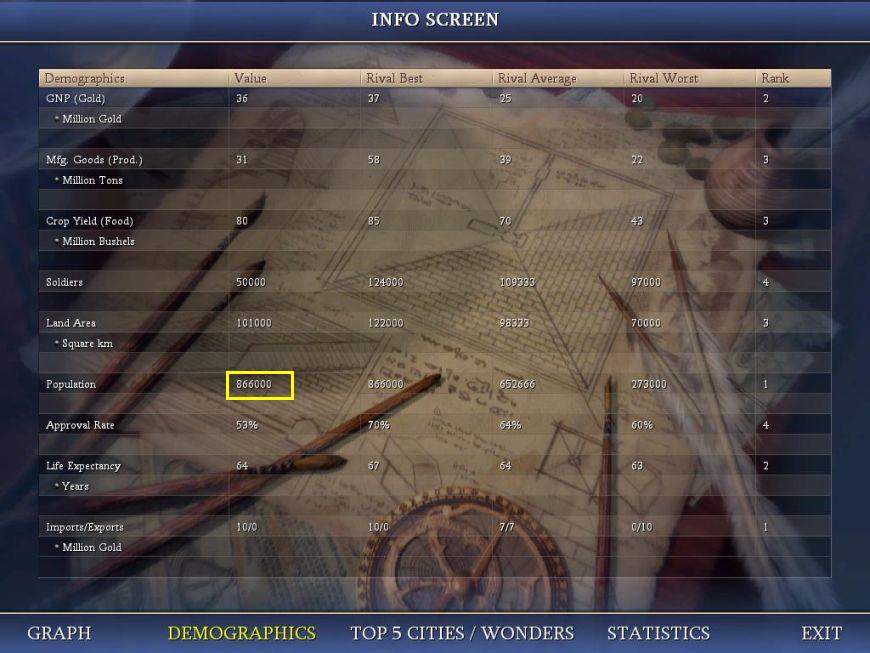
My population jumped from 470,000 the turn before the Gardens to 866,000 this turn. Wow! Jumped me up into first place in population on the rankings - can you guess who's last with a paltry 273,000?  I have no clue if that's good or not, but I certainly hope so. At the very least, I should score SOME points in this category; I'd be disappointed if 5 different people managed to get a higher population. I guess we'll find out on report day. Two alternate ways to get high populations here would include having fewer cities but ones with higher populations (you could probably do some interesting stuff with Hereditary Rule in this regard) or possibly by conquering some of Louis' cities and getting "free" population that way. I really pushed for this scoring goal, so I hope that I'll score something here, but we'll just have to wait and see.
I have no clue if that's good or not, but I certainly hope so. At the very least, I should score SOME points in this category; I'd be disappointed if 5 different people managed to get a higher population. I guess we'll find out on report day. Two alternate ways to get high populations here would include having fewer cities but ones with higher populations (you could probably do some interesting stuff with Hereditary Rule in this regard) or possibly by conquering some of Louis' cities and getting "free" population that way. I really pushed for this scoring goal, so I hope that I'll score something here, but we'll just have to wait and see.



